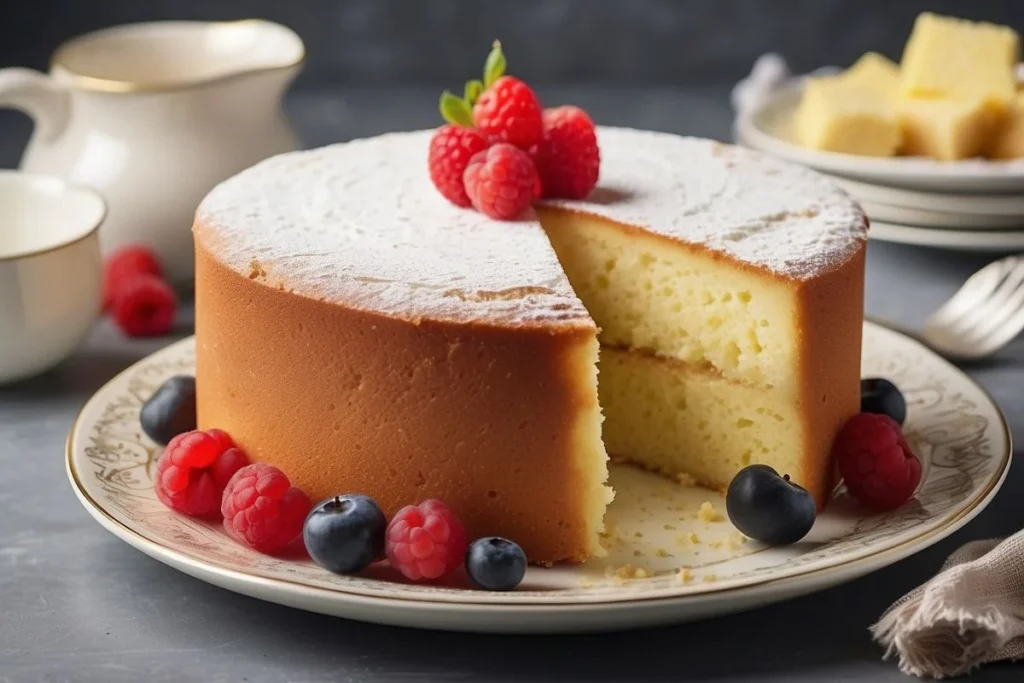
Why is My Sponge Cake Too Dense and How to Fix It
Sponge cakes, with their light and airy texture, are a delight to the palate when done right. However, every avid baker has faced the disappointment of a dense sponge cake at least once.
In this article, we’ll explore the reasons behind this baking problem and provide practical solutions to ensure your sponge cakes are always light, fluffy, and delicious.
Table of Contents
Toggle4 Common Causes Why Is Your Sponge Cake Too Dense
A yummy, fluffy sponge cake is a treat for the senses, but sometimes, no matter how hard you try, it ends up disappointingly heavy. Understanding why your sponge cake turns dense is key to getting that perfect, melt-in-the-mouth texture.
Mixing Too Much
One big reason your sponge cake might be dense is if you mix the batter too much. When you add flour to the wet stuff, it creates gluten. Mixing too long makes too much gluten, resulting in a heavy and tough cake.
To avoid this, gently mix the dry and wet ingredients until just combined. Be gentle and stop when you don’t see any flour streaks. Too much mixing messes up the delicate balance needed for a light sponge.
Not Measuring Right
Being precise when measuring ingredients is super important in baking. Straying from the recipe, whether by using too much flour or too little leavening agent, can seriously mess with the cake’s texture.
Too much flour makes it heavy, and not enough leavening agents like baking powder or baking soda mess with how the cake rises. Get accurate measuring tools, follow the recipe exactly, and make sure your baking powder is fresh to keep the delicate balance for a light sponge.
Not Creaming Butter and Sugar Properly
Creaming butter and sugar together to get air into the mix is a crucial step in making a sponge cake. If you don’t do it right, you’ll end up with a dense cake.
Make sure your butter is at room temperature and cream it with sugar until it’s light and fluffy. This airiness helps the cake rise when baking. Rushing through this step or using cold butter messes with the air, giving you a denser cake.
Wrong Oven Temperature
Baking is like a science experiment, and temperature is a big deal in getting the texture right. If your oven is at the wrong temperature, it can mess with how your sponge cake rises and holds together.
Too hot and the cake sets too fast on the outside, not letting it expand properly. Too low and it might not bake enough. Use an oven thermometer to be sure and follow the recipe’s temperature guidelines to get that perfectly risen and soft sponge cake.

How to Fix Too Dense Sponge Cake | A Step-by-Step Guide
If you’ve ever cut into what looked like a perfect sponge cake only to find it disappointingly dense, don’t worry. Fixing a cake like that just needs a careful approach and a few smart changes to how you bake.
Let’s go through a step-by-step guide to save your cake and make sure your future bakes turn out perfectly.
Step 1: Check the Density
Before you try to fix things, take a moment to see how dense your sponge cake is. Pay attention to its texture, crumb structure, and overall feel. This quick assessment will help you figure out what’s wrong and guide your next moves.
Step 2: Find the Problem
Dense sponge cakes can happen for different reasons, so figuring out the main issue is important. Think about things like overmixing, not measuring flour accurately, not using enough leavening agents, or having the oven temperature off. Knowing the problem will help you fix it the right way.
Step 3: Be Gentle with Folding
If you think overmixing is the issue, use gentle folding techniques to save your batter. Add a tablespoon of milk and fold it in carefully. This small addition can bring air back into the batter and fix the effects of overmixing.
Step 4: Adjust the Flour Amount
If your cake is too dense because of too much flour, adjust the amount of flour. Reduce it a bit in your recipe to get a better texture without messing up the structure.
Step 5: Boost Leavening Agents
If your cake isn’t rising enough, boosting leavening agents can help a lot. Find creative ways to enhance leavening naturally. Try adding yogurt, buttermilk, or vinegar to activate baking soda. Experiment with alternative leavening agents like whipped egg whites for a fluffier result.
Step 6: Check Your Oven
Make sure your oven is set to the right temperature. If the temperature is inconsistent, your cake might bake unevenly and end up dense. Use an oven thermometer to double-check your oven settings. Calibrating your oven ensures it’s reliable for successful baking.
Step 7: Experiment and Learn
Baking is always changing, and trying different things is key to getting better. After making changes, do small test batches to see how they affect the texture and density. Take notes on each variation to help you fine-tune your recipe for future bakes.
Step 8: Prevent Future Issues
Once you’ve saved a too-dense sponge cake, focus on preventing it from happening again. Use what you’ve learned in your routine, adjusting mixing times, flour amounts, and leavening agents for consistently light and fluffy results.

How to Fix a Dense Cake After Baking in 6 Easy Ways
Taking a bite of cake and realizing it’s denser than expected can be a bit disappointing, but don’t worry—there are ways to rescue your creation even after it comes out of the oven. Here’s a detailed guide on how to fix a dense cake after baking:
- Moisture Boost: One effective method involves adding moisture to the cake. Use a simple syrup, flavored if you like, and gently brush it over the cake’s surface. The syrup not only adds moisture but also brings in an extra layer of flavor. Make sure the cake has cooled a bit before applying to allow absorption without compromising its structure.
- Frosting Magic: A generous layer of frosting can do wonders in hiding a dense texture. Choose a light and fluffy frosting to create a pleasing contrast. Whipped cream or cream cheese frosting, with its airy consistency, can visually and texturally elevate the cake.
- Layered Transformation: Transform your dense cake into a layered masterpiece. Slice it horizontally into layers and spread a filling of your choice between each. Whether it’s fruit preserves, custard, or even a layer of whipped cream, these additions bring in moisture and complexity, turning the dense cake into a delightful tiered dessert.
- Pair with Complementary Goodies: Distract from the denseness by pairing your cake with complementary elements. Fresh fruits, a scoop of ice cream, or a drizzle of warm fruit compote can divert attention from the texture while enhancing the overall eating experience.
- Reheat and Steam: If the cake isn’t too far gone, reheating and steaming can help soften its texture. Wrap slices in a damp paper towel and microwave briefly, or place the entire cake in a steamer for a few minutes. This method works well for butter-based cakes.
- Crumb Coating: Apply a thin layer of frosting to the entire cake and let it set before adding the final layer. This not only improves the cake’s appearance but also adds an extra layer of moisture.

Tips for Achieving the Perfect Sponge Cake Texture
Baking has always been my go-to when I need a bit of relaxation, and mastering the art of making the perfect sponge cake has been a really fun journey. Getting that light and moist texture requires a mix of precision and passion.
Here are some tips that have made a difference in my baking:
First things first, you’ve got to use ingredients that are at room temperature. Make sure your eggs, butter, and milk aren’t straight out of the fridge. Having them at room temp makes it way easier to mix everything and gives you a smoother batter. This step is crucial for a cake that rises just right.
When it comes to dry ingredients, sifting is a game-changer. It not only gets rid of lumps but also adds air to the flour, making your batter lighter. The result? A sponge cake with a super tender crumb that practically melts in your mouth.
Whipping the eggs until they hit the ribbon stage is a big deal. That means beating the eggs until the mix turns pale and thick, leaving a ribbon-like trail when you lift the beaters. This step brings air into the batter, giving you that sought-after light and fluffy texture.
The type of flour you pick matters more than you might think. Go for cake flour instead of all-purpose flour for a finer, softer crumb. Cake flour has less protein, so your cake won’t end up dense. Instead, you get a wonderfully light cake.
Lastly, be patient while your cake bakes. A slow and steady rise in the oven gives you an even texture. Don’t be tempted to open the oven door too soon, or your cake might collapse.
Can You Eat a Dense Cake?
Absolutely! While a dense cake might not have the light and fluffy texture of traditional cakes, it’s edible. Whether you like your cake dense or airy is just a personal preference. Some folks enjoy the richer and more substantial feel of a dense cake.
Don’t worry, the flavor and ingredients are all there, guaranteeing a delicious experience. Whether you’re into a moist pound cake or a fudgy chocolate creation, enjoying a dense cake is all about your taste buds. So, go ahead and relish the unique charm of a dense cake—it’s a delightful treat for those who love a heartier dessert.
Conclusion
In the fun adventure of making the perfect sponge cake, we’ve discovered the tricks to getting that light and fluffy texture everyone loves. We’ve talked about why cakes might end up too dense and given you a step-by-step plan for fixing them.
Just remember, being careful with your measurements, mixing gently, and getting to know your oven are super important. Feel free to try new things, pick up lessons from each baking session, and enjoy the special appeal of a dense cake—it’s a tasty treat for those who like a heartier dessert. Happy baking!
Lindsey Mackenzie
About me
Hi there! I’m Lindsey Mackenzie, the founder of Bake Smartly. Baking has been my passion since childhood, growing up in my father’s bakery. With Bake Smartly, I’m excited to share my love for all things sweet and savory. Join me on this delicious journey as we whip up scrumptious treats and sprinkle joy into every bite!






